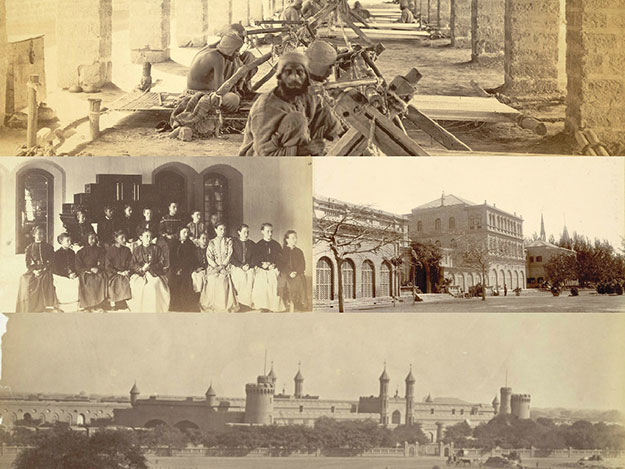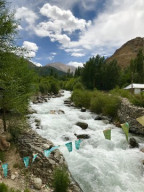
Things were, however, much different before we achieved independence. Here is a look at some fascinating images from pre-Partition:
1. The Church- Kurrachee

PHOTO: BRITISH LIBRARY
This Holy Trinty Church still stands today; however, the area around it today has been rebuilt. The football ground next to the church was home to the kindergarten section of Karachi Grammar School. This picture dates back to the 1800s.
2. Sind Club

SOURCE NOT VERIFIED
Taken by an unknown photographer in 1890, this picture shows Karachi's exclusive Sind Club, which started as a gentleman's club in 1877.
3. Murree

PHOTO: WILLIAM BAKER
This picture of Murree, taken by William Baker in 1865, is a stark reminder of how different Murree looks today.
4. Jhelum District

PHOTO: JOSEPH BEGLAR
Taken by Englishman Joseph Beglar in 1875 in Malot, the photograph shows a view of a cliff in Jhelum.
5. St Patrick's School in Karachi

SOURCE NOT VERIFIED
A girls classroom in St Patrick's School in Karachi. At the time of British India, educating girls was much neglected. Figures for all of India for 1871 suggested there were 1,760 primary schools and only 134 secondary schools, all which were situated in larger cities.
6. Zamzama Gun, Lahore

PHOTO: JAMES RICALTON
Taken in 1903 by James Ricalton, this photograph appeared in "The Underwood Travel Library: Stereoscopic views of India". According to the British Library archives, the Sikhs called Zamzama the "Bhangian-wali Top". It is said to have been used by Ahmed Shah in the Third Battle of Panipat (which is in present-day the Haryana state in India) in 1761.
7. Lahore Railway Station

PHOTO: GEORGE CRADDOCK
Taken in 1880 by George Craddock, this photograph is part of the Bellew Collection of Architectural Views.
8. Carpet weavers at Karachi Jail

PHOTO: MICHIE AND COMPANY
This photograph was taken in 1873 by Michie and Company for the Archaeological Survey of India Collections.
9. Potsellers

PHOTO: JAMES RICALTON
Potsellers in a Lahore market were photographed by James Ricalton in 1903 for "The Underwood Travel Library: Stereoscopic views of India".
10. District Court House of Gujranwala

SOURCE NOT VERIFIED
Taken by an unknown photographer in 1865 in Gujranwala.
11. Church in Gujranwala

SOURCE NOT VERIFIED
Taken for the Brandreth Collection: "Views in Simla, Cashmere and the Punjaub", an unidentified photographer captured this image in 1865. This city was Ranjit Singh's base till 1799 when he captured Lahore and declared it the capital of the Sikh kingdom.
12. The Great Stupa at Manikiala in Rawalpindi District (in present-day Gujar Khan tehsil)

PHOTO: JOSEPH BEGLAR
This photograph was taken for the Archaeological Survey of India Collections (Indian Museum Series) by Joseph Beglar in 1875. According to the British Library, the Archaeological Survey of India Report for the Year 1872-3 (Vol V) says: "The great tope of Manikyala is a hemisphere 127 feet 9 inches in diameter, resting on a cylindrical neck, 15 feet in height. The total height of the dome, as it now stands, is 92 feet 3 1/4 inches".
13. Muree in winter

PHOTO: BAKER AND BURKE
Pakistan's most famous hill station was established by the British in 1865 because its climate was closer to what they left behind in Britain. The image was taken by Baker and Burke in 1865.

















COMMENTS (3)
Comments are moderated and generally will be posted if they are on-topic and not abusive.
For more information, please see our Comments FAQ